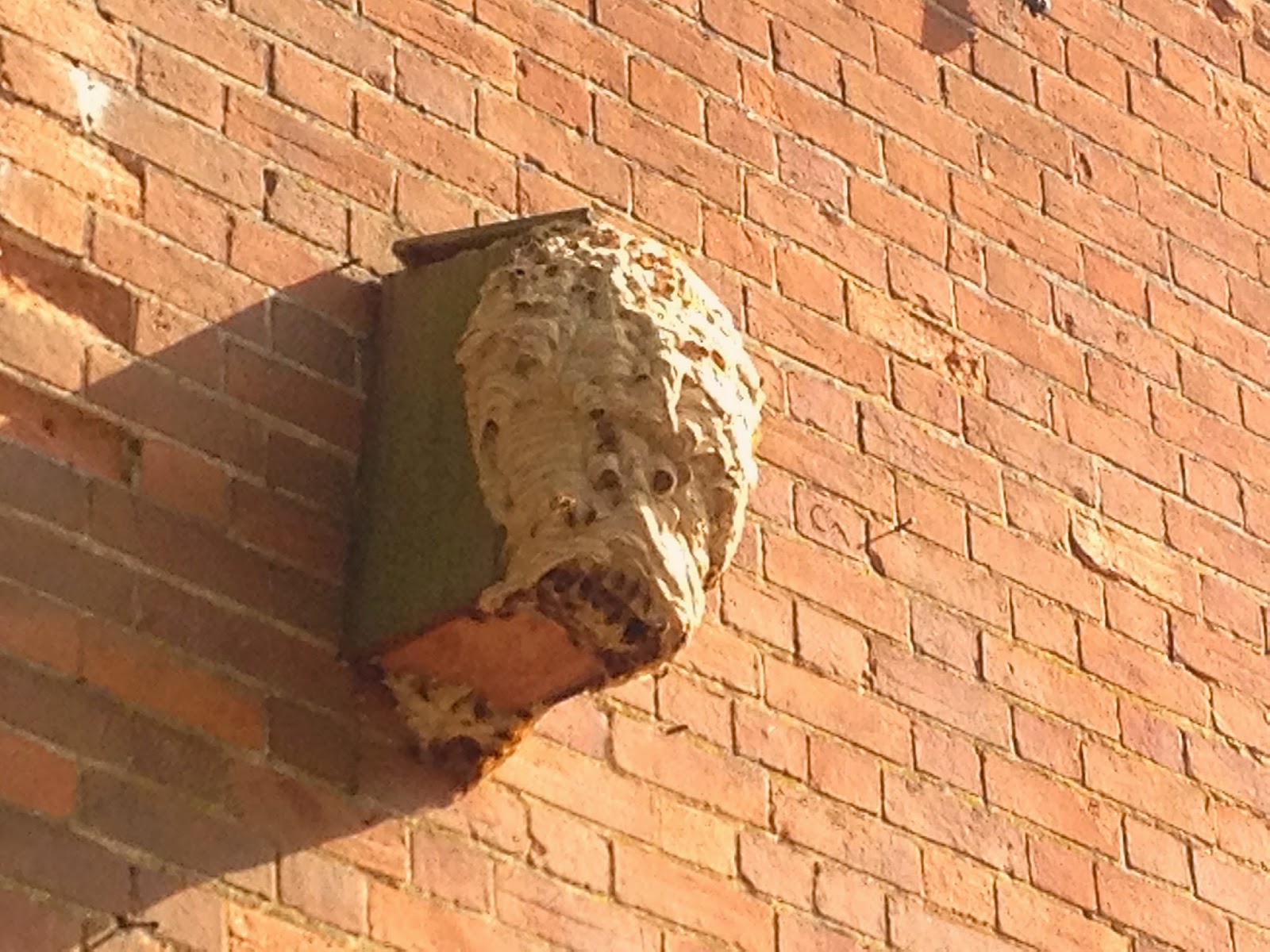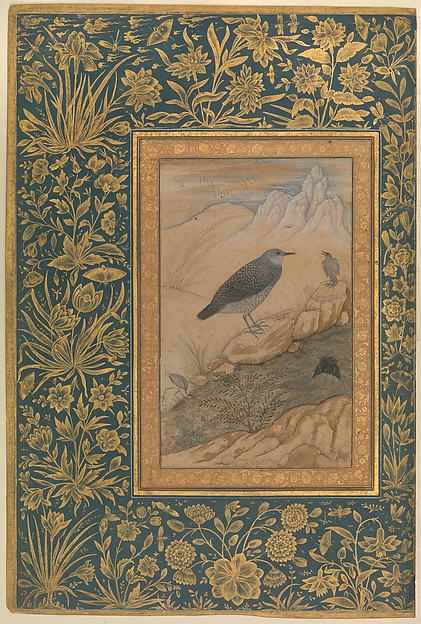I popped round to see some friends yesterday, and they proudly showed me this hornet's nest built out of an owl box on their neighbour's wall. This is not small. The sound of hundreds of hornets working away, a mixture of buzzing and a sort of crunching sound as they construct their paper walls is not to be forgotten. Fabulous.
A collection of writing, images and sounds inspired by natural history, by Somerset artist Duncan Cameron and Norfolk musician Adam Clark
Sunday, 28 September 2014
Saturday, 27 September 2014
Monday, 15 September 2014
Varroa Strips
Great session with Bob and the bees after work. Just working away in the apiary taking down all of the hives and putting in anti varroa strips. Having taken off the last honey before the winter, last weekend, we were putting in the strips to fumigate the hives and remove any varroh mites. When you peel off the covers on the strips the fumes are enough to make you wince and the bees clearly don't like it either, as you can see, with large groups streaming out of the entrance as you work although they soon settled down once we re-assembled the hive. When we retrieved the remains of the strips a week later the fumes had evaporated through the hive and the bees had stuck everything up with propolis so it was quite difficult to retrieve the bits of paper. The hives are all different, with some rather hot and buzzy and others much more settled and compliant. After the loss of several hives last spring, two of these colonies took up home here after bait hives were set up and they chose to move in.
fields
fields
Sunday, 14 September 2014
The Great Silver Diving Beetle
Cycled down to the Avalon Marshes centre and enjoyed some pond dipping with the boys. There were juvenile newts, frogs, boatmen and lots of beetles in the water. I was surprised at the size of the enormous Great Silver Water Beetles as I had mistakenly thought that the handsome Great Diving Beetle was our largest water beetle, but apparently not.
We also learnt that you can tell the male beetles from the females as the males have a small flap at the front of their front legs that the females don't have. Beautiful and impressive insects.
The Great Diving Beetle (Dytiscus marginalis)

The Great Silver Water Beetle (Hydrophilus piceus)
Saturday, 13 September 2014
Children and owl pellets
I was kindly asked to run my owl pellet table at the annual Ashcott Village Harvest Fayre. I didn't want to charge anything and wasn't selling anything and I am sure that it all bemused some of the parents, Q 'Are you the man letting children play with poo?'. I had to explain to many that it wasn't poo, it was more like sick or a cat's fur-ball, not everyone was re-assured. Many older village residents warmly remember the same activity from their childhood and in that sense I suppose it belongs to the same school of nostalgic country activities as tree houses, conkers and blackberry picking.
The children of course loved it. If you present a child with an owl pellet, a piece of card, some glue and a pair of tweezers they will quite happily spend an hour finding all of the bones. The level of focus and interest was quite astonishing, I wasn't astonished but many were and some had to be persuaded to give it a go. I spent 3 or more hours identifying bones and talking about prey species and swapping stories about owls. I found out about two roosts in the village, 1 tawny and 1 barn, and helped identify innumerable bones and bone fragments. The children were soon explaining to other children about identifying shrews by their long noses and red teeth and calling out ' I've got another vole femur'. As the bones were identified and compared to human equivalents there was lots of discussion. On finding two skulls in one pellet one child was very excited abut finding a two headed mouse, I didn't want to suggest a less exciting alternative interpretation. Parents often stayed to help but were also clearly interested and the children went off happily into the crowds with their bones stuck carefully to cards. Children are so naturally enquiring and as they focused intently on the task in hand I was keenly aware that these eager little minds will be the future conservationists, artists, naturalists or perhaps forensic pathologists.
Thursday, 11 September 2014
The wonder of birds
Finally made it to Norwich Castle Museum's 'The Wonder of Birds' exhibition before it closes on Sunday. As well as reminding myself how much I like the work of Robert Gillmor I also came across a piece by the 16th century Indian artist Mansur. Just exquisite.
Sunday, 7 September 2014
Stiffkey
 A weekend camping on the North Norfolk coast at Stiffkey gave us the opportunity to explore the saltmarsh that lies between the coastal chalk ridge and the sea.
A weekend camping on the North Norfolk coast at Stiffkey gave us the opportunity to explore the saltmarsh that lies between the coastal chalk ridge and the sea.As we left the campsite with its late low-flying swallows behind, we came first across the marsh, a massive expanse of vegetated mud cut through with rivulets and creeks, which fill and empty with the tides. This habitat stretches for half a mile or so towards the sea, not quite dry land, not yet beach proper, a liminal zone yet a fully formed ecosystem in its own right.
Some of the creeks are wide enough to merit bridging, and at high tide navigable by boat; boats that at low tide remain marooned in the middle of the landscape as if picked up and abandoned by a petulant giant-child.
 Although it seems a bleak landscape, closer inspection shows that it is thrumming with life. The waterways are living capillaries that abound with crabs, shrimps and tiny fish that scatter and shoot as soon as our step is felt. Wormcasts and shells are ample evidence of the huge seafood platter that provides sustenance for the myriad waders and gulls that flit idly across the landscape or pick away at the mud. These assorted birds provide the notable feature of the soundscape, their wailing ululations rising occasionally to piercing banshee wails.
Although it seems a bleak landscape, closer inspection shows that it is thrumming with life. The waterways are living capillaries that abound with crabs, shrimps and tiny fish that scatter and shoot as soon as our step is felt. Wormcasts and shells are ample evidence of the huge seafood platter that provides sustenance for the myriad waders and gulls that flit idly across the landscape or pick away at the mud. These assorted birds provide the notable feature of the soundscape, their wailing ululations rising occasionally to piercing banshee wails.As we tried to work a way around one of the waterways, a couple of other walkers arrive, one of whom turned out to be my erstwhile maths teacher. A brief conversation ensued, covering 25 years of biography, the changing face of North Norfolk, the joys of retirement, the balance between singing and dancing prowess in West Side Story and local chamber music. Strange how we can extemporise a polite drawing room in a wild backdrop.
 A goodbye, a parting and we move on beyond the marsh proper over the lowest of dunes to the even bleaker sandflats beyond. At this point the pipleline that runs across the marsh stands out as the main feature of this alien landscape beyond which lies nothing but north sea and the end of Blakeney Point before the arctic ice. On a sunny late summer day it feels like a benign wilderness in which to wander; what could go wrong? But as the long-stretching sky reflects in the wet sand and the absence of landmarks to anchor yourself starts to take effect, one can easily imagine becoming turned round, unsure whether one is heading back to land and safety, or out to sea-borne danger. Throw in some gloom, or even some autumnal mist with a rising tide, and this could be a lethal beauty.
A goodbye, a parting and we move on beyond the marsh proper over the lowest of dunes to the even bleaker sandflats beyond. At this point the pipleline that runs across the marsh stands out as the main feature of this alien landscape beyond which lies nothing but north sea and the end of Blakeney Point before the arctic ice. On a sunny late summer day it feels like a benign wilderness in which to wander; what could go wrong? But as the long-stretching sky reflects in the wet sand and the absence of landmarks to anchor yourself starts to take effect, one can easily imagine becoming turned round, unsure whether one is heading back to land and safety, or out to sea-borne danger. Throw in some gloom, or even some autumnal mist with a rising tide, and this could be a lethal beauty. And so we turn, back to the marginally firmer land of the marsh. Back across the creeks and crannies, the muted purples of the sea lavender amongst the green hues of salt-marsh grasses, pausing only to note the colourful washes in certain pools, and a bleached skeleton crab, whilst the redshank yells its outrage at a bullying gull. And then we are glad to be back; back to the land, back to the reassurance of chalk underfoot, back to our certainties.
And so we turn, back to the marginally firmer land of the marsh. Back across the creeks and crannies, the muted purples of the sea lavender amongst the green hues of salt-marsh grasses, pausing only to note the colourful washes in certain pools, and a bleached skeleton crab, whilst the redshank yells its outrage at a bullying gull. And then we are glad to be back; back to the land, back to the reassurance of chalk underfoot, back to our certainties.
Subscribe to:
Posts (Atom)



















